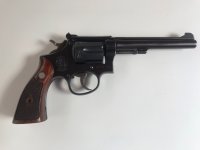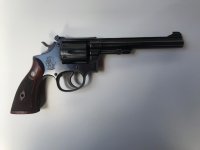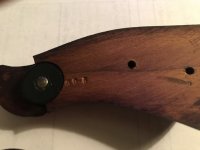Eric158
Member
I need help from Forum members regarding "high horn" and "sharp shoulder" magna grips. I just acquired a K-22 Combat Masterpiece, Serial# 128XXX, which I believe dates it to 1951. Unfortunately the original grips are missing. I'd like to pick up a pair of diamond magnas off eBay, but am not sure which style would be correct. I've read past discussions on this issue, but it still confuses me. Would someone please tell me which style would be correct for my 1951 K frame, and show me how to differentiate it from the other style - maybe with photos? I've identified some potential grips on eBay.
Last edited by a moderator:











![IMG_E0056[1].jpg](https://cdn.smith-wessonforum.com/attachments/301/301380-346c7cb0965fbb392b3e0e6205222cf2.jpg?hash=mrKPRlLjNd)
